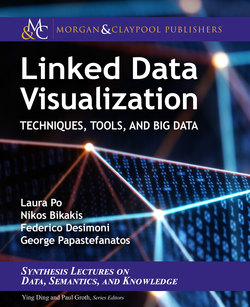Читать книгу Linked Data Visualization - Laura Po - Страница 8
На сайте Литреса книга снята с продажи.
ОглавлениеPreface
The Linked Data Principles defined by Tim Berners-Lee promise that a large portion of Web Data will be usable as one big interlinked RDF database. Today, we are assisting the staggering growth in both the production and consumption of Linked Data (LD) coming from diverse domains such as health and biology, humanities and social sciences, or open government. In the early phases of LD adoption, most efforts focused on the representation and publication of large volumes of privately held data in the form of Linked Open Data (LOD), contributing to the generation of the Linked Open Data Cloud.
Nowadays, given the wide adoption and availability of a very large number of LD sources, it is crucial to provide intuitive tools for researchers, data scientists, and domain experts as well as business users and citizens to visualize and interact with increasingly large datasets. Visual analytics integrates the analytic capabilities of the computer and the abilities of the human analyst, allowing novel discoveries and empowering individuals to take control of the analytical process. LD visualization aims to provide graphical representations of datasets or of some information of interest selected by a user, with the aim of facilitating their analysis and generating insights into complex interconnected information. Visualization techniques can vary according to the domain, the type of data, the task that the user is trying to perform, as well as the characteristics of the user (e.g., skills).
This book presents the principles of LD visualization, as well as demonstrates and evaluates state-of-the-art LD visualization tools. Moreover, future challenges and opportunities in the field of Big (Linked) Data visualization are presented.
The book is written for everyone who wants to explore and exploit LD, whether undergraduate and post-graduate students, data scientists, semantic technology developers, or UI & UX designers who wish to gain some practical experience with LD tools. Previous knowledge of Semantic Web technologies such as RDF, OWL, SPARQL, or programming skills is not required. The purpose of this book is to empower readers of any background to get started with their own experiments on the LOD Cloud, select the most appropriate LD tool for each scenario, and be aware of the challenges and techniques related to Big Linked Data exploration.
Since readers are likely to have a wide variety of different backgrounds, each chapter presents an overview of its content at the beginning. A reader who wishes to have a quick overview can start with the first page of each chapter. When the material in any section becomes more advanced, the reader can skip to the beginning of the next section without losing continuity. Chapter 1 introduces the Web of Linked Data, describing the phenomenon of the production and consumption of LD, the social and economic impact that this data has, and the effect that visualization tools can have in facilitating the understanding and exploitation of such data. Moreover, it presents the principles of LD and the technologies of the Semantic Web Stack. Chapter 2 addresses how data can be presented in visual form, focusing on interactive and specialized visualizations of proportions, relationships, and spatial data. Further, it introduces the new challenges and methods related to Big Data Visualization. Chapter 3 surveys the variety of linked data visualization tools. Chapter 4 defines and models a set of visualization use cases based on the users’ requirements in LD exploration. Chapter 5 describes a wide empirical evaluation of the tools introduced in Chapter 3. Here, a practical evaluation of the tools will be shown in order to describe their characteristics and limitations as well as formalize how the tools handle the use cases described in Chapter 4. Chapter 6 reports some conclusions and open issues and suggests research challenges and promising trends for the future.
Laura Po, Nikos Bikakis, Federico Desimoni, and George Papastefanatos
March 2020
